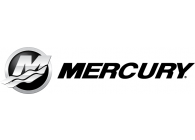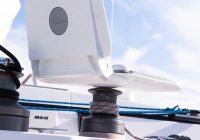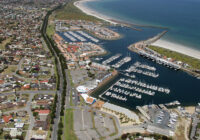Just over fifteen years ago, Outboard Marine Corporation (OMC), once the world’s largest manufacturer of outboard motors, filed for bankruptcy. How this legendary conglomerate went from being an international institution for much of the 20th century to a virtual also-ran at the birth of the 21st is still the source of much debate. Danny Casey argues that the industry has never been the same since.
REQUIEM FOR A HEAVYWEIGHT
On New Year’s Eve, 2000, when I was a territory manager for a Japanese outboard manufacturer, I and my wife were enjoying a carefree, idyllic week mooching around the Bay of Islands when my phone rang with an international call – very rare in those days as international roaming wasn’t so commonplace and people tended to accept that you just weren’t available while on holiday. On the line was a successful Australian marine dealer, who had literally, over five decades, sold thousands of Johnson outboards. He asked me if I’d heard the news about OMC, which indeed I had, and he asked me to come see him as soon as possible as he thought he might need my help…
This dealer had cautiously been starting to promote engines from the 4-stroke brand I then represented, and was offering them as a quirky and higher-priced alternative to the Johnsons he sold by the truckload. Whilst he was far from distraught (he was much too professional and measured to let emotion enter into it), I could tell he was shocked and worried about the future, as the OMC product on which he had built his livelihood would probably no longer take prime position in any reorganisation of the business. He asked for support with my product as he tried to realign the type of business he would subsequently run – a request with which I was more than happy to oblige. There is no doubt that it took the OMC bankruptcy to shake this dealer from complacency and make him realise that perhaps there was a more sustainable future in specialised and upper-echelon products.
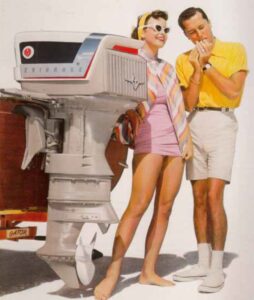
The most technologically advanced outboard for its time, the 50hp V4 was introduced in 1958
WHAT WENT WRONG?
How did a company that supplied over 50% of the outboard motors sold globally in the 1960s end up being virtually irrelevant by the end of the 1990s? This company had two magnificent brands: Evinrude (with a history as old as the outboard itself) and Johnson (at one time, in deepest Africa, the generic term for outboard motor was “Johnson”). They were also nimbly adept in identifying the need for a budget line to be sold in sportsman-type stores, so they introduced the ephemeral but expediently successful Gale brand in the mid-late 1950s. In OMC’s truly halcyon days during the 1960s, they also manufactured diversified products such as chainsaws (Pioneer), lawnmowers (Lawn Boy) and snowmobiles (Johnson Skee Horse and Evinrude Skeeter). This list of supplementary products is not complete, but it does illustrate the nous, ingenuity and capability OMC once had. Whereas its marketing efforts were always somewhat jumbled, confused and disjointed, it was a manufacturing company second to none, and its in-house production of key components like crankshafts, pistons, carburettors and electrical systems ensured it had, in its day, a rigorous quality-assurance programme which presciently preceded any such programmes introduced subsequently by others in the late ’80 and early ‘90s. To plummet from the heady heights of world domination in the early 1960s to being a mere supporting player by the end of the 20th century took mishaps, follies, personality clashes, rash acquisitions along with an unbridled arrogance and a stubborn refusal to acknowledge – until much too late – that the Japanese were a genuine threat. One can only scratch the surface of why OMC finally went over the precipice and, as such, any observations, comments and opinions in this article will not be overly comprehensive, conclusive or definitive. But for those of us who grew up with, and used, what were arguably the best products of their type (and of their time) produced by any manufacturer in any industry, let’s try to understand how they went from top dog to underdog.
THE PERSONALITIES
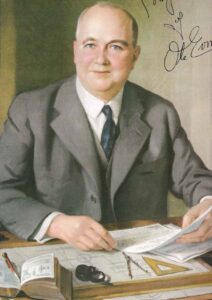
Ole Evinrude the man who supposedly “invented” the whole outboard concept
To be relevant to the key period being chronicled, it is probably better to skip the really early stuff and jump to the mid-1930s. After all, nothing that happened in the early years of the 20th century has any bearing whatsoever on the demise of OMC just as the 21st century dawned.
Of the main players who had amalgamated to become firstly the Outboard Marine and Manufacturing Company and subsequently Outboard Marine Corporation, the best known was probably Ralph Evinrude. He was the son of Ole Evinrude, who supposedly “invented” the whole outboard concept – hotly disputed by Carl Kiekhaefer of Mercury, although that forms no part of this story. However, we will concede that Ole Evinrude invented the first commercially-viable outboard. Also central to the story are the Johnson brothers, Harry, Lou and Clarence (who had made and flown one of the first successful monoplanes), and Stephen F. Briggs (of Briggs and Stratton fame).
Of the entire cast of characters, Briggs, although not an out-and-outboard “name”, should possibly be recognised as the most aggressive, farsighted and entrepreneurial of them all. Without Briggs, there would have been severe reluctance to forge ahead with then-alien concepts like the recoil starter, the separate fuel tank and remote controls. Also, in an effort to capitalise on OMC’s collective strength, it was Briggs who instigated – with huge internal resistance from those determined to protect each brand’s name and identity – the policy of integration in manufacture, where both brands were manufactured from the same components, in virtually the same configuration, by the same assembly procedures. The only differences were colour, cowling shape, styling and decals. It could be posited, therefore, that Briggs was a successful proponent of “badge” engineering.
EARLY WARNING SIGNS
Hindsight being frequently regarded as a substitute for foresight, when one looks at the catastrophic results of badge engineering in the automotive industry, taking as an example a torpid, moribund black hole like BMC (Austin, Morris, Wolseley, Riley), and also noting how, due to product overlap, Chrysler dropped Plymouth and GM nixed Oldsmobile, it is a wonder that OMC prospered as it did for decades. The cost of maintaining multiple facilities must have been excruciatingly expensive, not to mention having to entirely change the paint in the spray vats – in the ‘50s, ‘60s, ‘70s and for most of the ‘80s, Johnson and Evinrude outboards shared no like coloured external parts whatsoever. Another business idiosyncrasy was that Johnson and Evinrude had, in North America at least, two entirely ways of getting their product into the hands of customers. Johnson went directly to its dealers whilst Evinrude used a strategic network of distributors who would service the dealers in their regions.
It takes an exceptional (and ultimately frustratingly futile) amount of effort to market and sell two identical products which are identical siblings but pitched as competitors. By and large, OMC was inordinately skilled at this, whereby – up until the mid-1990s at least – advertising material for each of their brands would in no way allude to the other or to the collective strength gained from having a large parent company. Even a layman would have opined that the marketing layout people and copywriters for each brand were probably different – maybe they were – but again with hindsight, anybody possessing even an ounce of business acumen would realise that these divergent, go-our-own-way branding strategies were ultimately unsustainable.
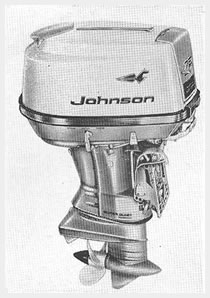
The 1963 Johnson Sea Horse four cylinder V-75 had Electromatic drive with a single lever remote control
THE HIGHS
Those who think that Outboard Marine Corporation was an unwieldy, uncoordinated and ineffective behemoth should really think again. When they were focused and resolutely on their game (and the 1960s were undoubtedly their glory period), nobody could match them. In 1968, they introduced the first of an entirely new breed of motor that set a precedent and would become an industry standard – for both them and their competitors – for as long as 2-stroke outboards continued to be made. It was the 3-cylinder, 814cc 55hp, the first-ever OMC motor to feature a through-prop exhaust and the first motor to adopt the slimline, straight-edged external profile that it (and its competitors) would use for the next 4-5 decades.
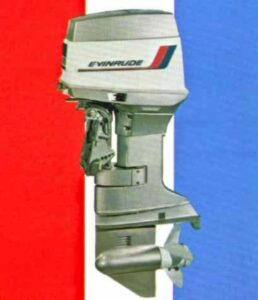
3-cylinder, 814cc 55hp
What was unusual at the time, though, was that this motor featured loop charging instead of the old-fashioned and relatively crude cross-flow system. Cross-flow induction uses a large deflector on top of the piston to push the incoming fuel/air mixture upward and across the cylinder which, in turn, pushes the spent charge out the exhaust ports. The OMC “looper”, however, had flat-topped pistons, which enabled much better induction, combustion and exhaust through more ideally positioned porting.
OMC more or less produced this original 814cc engine – eventually developing 75hp – up until the mid 1980s, when they introduced a newer (and, to many minds, inferior) 920cc triple with lost-wax castings. What must be borne in mind, though, is that when three of the four Japanese manufacturers (not Honda, obviously) wanted to make higher-HP outboards, the one engine they slavishly emulated was the 3-cylinder OMC looper. It may not, therefore, be too much of a stretch to say that there would be no Japanese outboard industry of any consequence had OMC not introduced that first 55hp back in 1968.

When people think of outboard racing, the brand that is top of mind is Mercury. However, when Charles Strang (who had designed both the Mercury 6-cylinder tower of power and the sterndrive concept when he worked for Carl Kiekhaefer at Mercury) joined OMC in the late 1960s before eventually becoming president in 1974, he decided that OMC’s relatively staid image needed burnishing.
Although OMC had set a world outboard speed record of 131 mph in 1966 with a V4 power unit on the hydroplane Starflite IV, little had been done since to keep the fervour alive. Strang revitalised the competition programme and also announced OMC’s intention to lead the horsepower race in consumer outboards. In the early 1970s, when the first V6 prototype came on the scene in the guise of Mercury’s 2 litre T3 racing outboard, OMC were left flat-footed. Mercury had laid claim to – and had patented – the concept of a loop-charged V6 with a 60-degree angle whereas the best OMC could muster was the venerable cross-flow 90-degree V4 with roots back to 1958. Strang, undeterred, ordered the first V6 prototypes (still 90 degrees as they couldn’t utilise Mercury’s 60-degree concept) knocked up by welding together the major parts of two V4 crankshafts and making sand-cast engine casings to accommodate them. But as an OMC V4 was 1,632cc, they had to sleeve the bores so the 6-cylinder motor could run in the then 2-litre ON tunnel boat class. This they did, and these cobbled-up V6s won decisively at Windermere and Paris in 1973.
Another example of OMC’s advanced thinking was the rotary outboard. By the early 1970s, the two main proponents of Dr. Wankel’s rotary engine, NSU and Mazda, were in trouble with the concept, the main reasons being oil/fuel consumption as well as bearing and rotor seal wear. Although it would eventually prove to be a technological dead end, OMC vigorously embraced the development of a rotary outboard.
Starting with two twin-rotor engines from their snowmobiles, coupled together to give a 4-rotor power unit, their first elementary and relatively low-powered prototypes, built purely for competition, were delivering over 260 hp @ 7,000RPM and reportedly burning under 70 litres of regular fuel per hour.
The rotaries are very rare and few people have ever seen one, with fewer than ten built. Four supposedly still existed, two outer shells and two complete engines, with the latter two bought by a collector. When BRP took control of OMC in 2001, they reportedly disposed of every aspect of the rotary programme, which is a huge shame because, the short-lived nature of the project notwithstanding, it was widely acknowledged that OMC had done far more Wankel development, and was far more advanced in the quest for durability and dependability, than both Mazda and NSU.
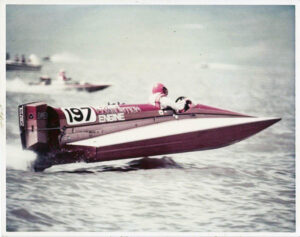
Another innovative product – not as dazzling, but no less significant – was a unique 3hp motor ideally suited for duck shooters. It had a slimline lower unit with a downward-slanted propeller so it could glide through weeds and underwater growth. Most interesting, though, was the fact that it actually “folded” – i.e. the leg pivoted in two and the lower unit folded upward. This meant that the motor could fit into a valise or the tightest storage space. These motors, too, are surprisingly rare, and I only ever saw one in the early ‘70s, stowed in a tiny yacht lazarette.
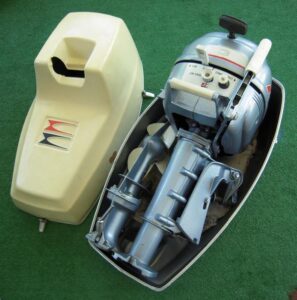
3hp motor
The 9.5hp fishing motor, introduced in 1964, also deserves a mention. To this day, there has never been a more compact, better-proportioned motor in this class. This low-profile motor was set down into the mid section rather than built upwards – the flywheel was virtually level with the front fascia panel and, unusual for OMC, it had a rear-mounted downdraught carburettor. It had a squat, pancake-shaped cowling which was flat on top – it was one of the tidiest, neatest little outboards one could ever put on a dinghy or inflatable.
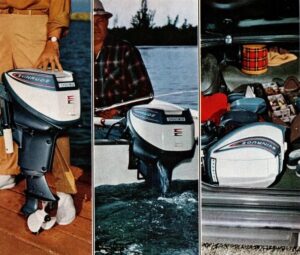
9.5hp fishing motor
THE LOWS
In 1980, OMC decided to mount a serious onslaught on the inboard and sterndrive sector by offering an externally-mounted outboard-based system for those larger boat types. Simply put, it was a V4 or V6 outboard (minus the traditional clamp bracket) affixed to a special mounting plate. In this way, the entire power unit was outside the boat, with no transom well to compromise aft freeboard, and no power unit stealing cockpit space. A huge benefit – compared with sterndrives or traditional shafts – was that the unit could tilt entirely clear of the water and would not be susceptible to corrosion, electrolysis or marine growth.
The Sea Drive system was basically a standard outboard plus an extra 400+ parts incorporated in the transom mount. Whilst proof positive of OMC’s engineering nous and ingenuity at the time, it was a prime example of dead-end engineering that was doomed from the outset. Within two years, many bluewater boatbuilders were fitting purpose-built outboard brackets from companies like Armstrong and Gil, making mounting conventional outboards on big boats a breeze. Then, when builders began to integrate pods onto boat transoms, the Sea Drive went the way of the 8-track tape.
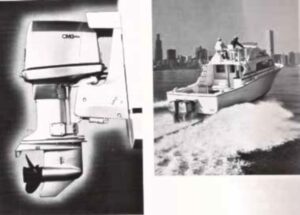
The very name “Outboard Marine Corporation” says it all about their key focus – they made outboard motors. Their approach to, and involvement in, the sterndrive business was initially lukewarm and ambivalent as they were, in the early days, up against myriad Volvo and Mercury patents relating to universal drive joints, trim systems and even the ignition-interrupting micro-switches that facilitated gear shifting. Leaving aside their first attempt, which was a V4 outboard power unit attached to a sterndrive leg, OMC’s first real effort, which used the same automotive based engines then available to Mercury and Volvo, was what was known as the “stringer mount” system – i.e. the complete assembly (engine and drive unit) was mounted on the boat’s stringers. The transom bore no weight and the huge aperture cut in it to allow the sterndrive to sit outside was sealed with a like-sized rubber gaiter.
Where Mercury and Volvo used universal joints to supply power to the drive and to allow it to tilt and swivel, OMC used what was known as a “ball-gear” system. This was similar in concept to the two meshing ball gears found on OMC outboard throttle rod linkages, only about 100 times larger. Of course, for the motor to actually drive the prop smoothly and effectively, the ball gears on both the drive and the back of the inboard engine had to mesh perfectly, i.e. lock together. As this theoretically caused a problem in relation to how to trim the boat (because the leg couldn’t be moved separately), the whole engine/leg assembly was moved up or down by a trim pump on the floor of the boat.
Again, this was convoluted and complex engineering – ingenuity purely for the sake of it. As previously noted, the stringer-mounts were thwarted at every turn by Volvo and Mercury patents, so as an exercise in how to circumvent patents and show individuality and creativity, this product was certainly an engineering success but a catastrophic commercial failure.
What an irony when one considers that, by the mid-1980s, with the patent issues no longer relevant, leaving OMC free to introduce the Cobra stern, they subsequently turned in a sterling performance with the then-revolutionary Steyr diesel on a coneclutch King Cobra leg in 1991 – truly the first lightweight, high-performance diesel sterndrive. But it was too little, too late. Their momentum and enthusiasm had gone and they offloaded the whole Cobra business to Volvo Penta.
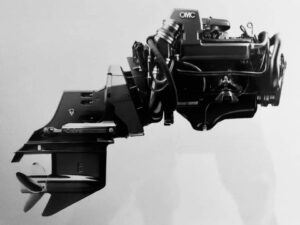
Cobra stern
By the mid-1990s, the US EPA was drawing up draconian regulations for marine-engine emissions which would eventually mean the end of conventional 2-strokes. I believe that if one is to sift analytically through the factors contributing to the eventual demise of OMC, then arguably this is the one that probably wounded them mortally – it was a slow, tortuous death but many feel that the cleanair demands placed on an already-ailing company proved to be the last straw. The manufacturers least inconvenienced by these stringent EPA regulations were the Japanese, as they also produced millions of 4-stroke engines for automotive use. It is not that the Japanese particularly wanted to switch to 4-strokes (after all 2-strokes were very cheap to manufacture and the tooling costs amortised over many years), but they had that option. At that time, if one were to pick a US manufacturer in a vulnerable position, one would firstly have thought of Mercury, but this proved not to be so. They were able to buy in some 4-stroke units from their old OEM partner, Yamaha, whilst taking out an option on Orbital DI 2-stroke technology. OMC, on the other hand, still had virtually zilch.
However, once the EPA started to further rattle its sabres, OMC implemented a programme called LEAP (Lean Emission, Advanced Propulsion), also espousing direct injection 2-stroke technology. By this time, they had gained the rights to use the Ficht direct-injection system – and this was to deliver the final, fatal blow.
To explore the whole history of Ficht would require a thesis size dissertation but, in layman’s terms, all we need to know is that the processes of controlling the spark advance, the fuel burn, the scavenging, and synchronising the intake and exhaust cycles in relation to piston/port position proved beyond the capabilities of OMC at that time. This was partly due to the precise and split-second calibrations that the new technology required, but also down to the appalling standard of OMC’s internal engine components – once proudly built in- house but now farmed out to subcontractors or to remote OMC plants in either the southern states or Mexico (more later).
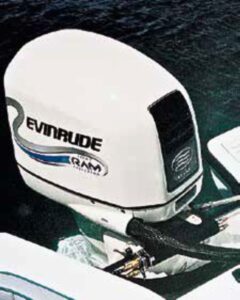
What is not widely known about this period is that, unlike Mercury, OMC did manufacture their own 4-strokes, albeit in small sizes of 8, 9.9 and 15hp, and it is a common misconception that they were sourced from Suzuki. Good little engines they were, too, albeit somewhat bulky and wide (because they used a spin-off oil filter), but the Ficht fiasco would decisively overshadow any such minor triumphs.
THE WOES
One thing that had always dogged OMC, as with many companies in the Midwest, was labour costs. In that industrial belt, the unions were militant, highly organised and very powerful. OMC fumbled through decades of duck-and-weave negotiations with the unions and eventually decided to build key facilities in non-unionised states such as Georgia. They also opened a new facility in Mexico.
Going back to the earlier point about OMC being a “manufacturing” company, where they made their vital engine components inhouse and outsourced little, one can imagine the huge culture shock. In fact, this decision – leaving the Ficht debacle aside – played a key part in OMC’s demise. Major parts of engines were assembled in the Calhoun, Georgia plant and sent to Waukegan, Illinois for final assembly – OMC insiders referred to this process as the “2,000 mile production line”. There was no way quality control could be maintained as there were too many variables and too much dependence on logistics. Likewise, the failure rate was legendary on the ground-breaking optical ignition system for the new Elan 35hp and 60-degree V4/V6 motors. The stator was made in Mexico and there are stories of defective items being returned only to be repacked and sent out again.
OMC was always preoccupied, to the point of obsession, about doing Mercury damage. During the ‘80s and ‘90s, Mercury had been exceptionally busy with a “vertical integration” policy, namely the buying of boat companies to guarantee them transoms for their engines. Mercury’s parent, Brunswick, had made some good acquisitions in Bayliner, Sea Ray and (later) Boston Whaler, among others. OMC, not wanting to be trumped, went on a massive buying spree of boat companies – all good names like Chris Craft, Four Winns, Donzi, Sunbird, Seaswirl, Ryds (Sweden) and Haines Hunter and Stacer in Australia.
All this was during the late ‘80s and long before Ficht and the other problems would eventually deliver the killer blow, but OMC’s core outboard product was weak – it was crude, behind the times, inordinately thirsty (even by the 2-stroke standards of the time) and increasingly unreliable. In short, they became carried away with hubris and grandiose ideas of supremacy, and took their eye off the ball.
On top of the financial woes, there was another, more unsavoury and literally toxic issue bubbling away under the surface. From the early 1960s until the early 1970s, OMC, at its Waukegan plant used fluids containing the toxin PCB (polychlorinated biphenyls) in its die-casting processes. The PCBs were flushed down floor drains and flowed straight into the nearby harbour. As far back as 1992, OMC was being pressured by the local government and the EPA to clean up the mess and did indeed contribute $20-25 million. Even today, over fifteen years after OMC went bankrupt, there are still issues with both the water and soil around their old plant and, had they continued, it is possible that ongoing remediation costs would still have eventually hamstrung them to the point of bankruptcy.
DEMISE
The end of OMC, when it finally came, was as convoluted and complex as any of its tribulations over the years. The original “old” Outboard Marine Corporation was in huge financial strife by 1997 and had asked Salomon Brothers to investigate either attracting a partner or entering into a merger. Roger Penske, of Detroit Diesel, made a bid for OMC based on $16 per share which, to all intents and purposes, had been tacitly accepted. Things were looking rosy; with a confirmed “engine” man at the helm, the company would no longer be left languishing and would soon be able to rectify any engineering problems and start regaining market acceptance.
What happened, though, has never been fully understood. Roger Penske’s bid was trumped by the Kingsley-Soros Group (known as Greenway group) at $18 per share. Whilst Penske had a blue-chip engine background, the same could not be said of Soros and Kingsley but it is suggested that Soros saw potential in Ficht in relation to licensing with other engine and motorcycle manufacturers. One of the greatest “hypotheticals” must certainly be if Penske the engine man would have kept the boat companies. Extremely doubtful, but the outboard unit may well have turned into a paradigm of efficiency, professionalism and, almost certainly, sustained profitability.
Greenway Group subsequently bought and ran a “new” OMC until the axe finally fell in December 2000 and Bombardier bought it at knock-down pricing. Ironically, lest anybody think that the revamped Evinrude DI system which supplanted Ficht was solely down to Bombardier, this is not correct. OMC had been well on the way to resolving the issues when, as fate decreed, they finally ran out of luck and money.
The demise of an industry icon like OMC can never be trivialised, as the ramifications were seismic and pronounced. The Japanese fortuitously amassed huge market share and had to do little to gain it, plus the demise of a long-time foe doubtlessly made Mercury focus even harder on their engineering and new-product strategies.
One of the original OMC brands, Evinrude, is still around, but as an ex-OMC dealer, boater and outboard racer, I was Johnson to the core – I never would have had an Evinrude engine on my boat. Silly, that, but I’d bet there are thousands like me. Now the Johnson brand is no longer around and that, for me, has changed the marine world immensely. One need only look at what happened to the Packards, Studebakers, Nortons and BSAs of this world. Producing iconic brands is not enough – management must have a core, driven passion to ensure their survival.
Danny Casey is highly experienced, undoubtedly idiosyncratic, and immensely knowledgeable about things mechanical, new or old. His knowledge and passion are as a result of spending his whole life in or around anything power-driven – especially marine engines. His passion for boating is second to none, with his life a montage of fabulous memories from decades spent in or around water and boats, both here and in Europe. Danny has spent myriad years in the recreational marine industry in a varied career in which he has bamboozled colleagues and competitors alike with his well-honed insight.

His mellifluous Irish accent, however, has at times been known to become somewhat less intelligible in occasional attempts at deliberate vagueness or when trying to prevent others from proffering a counter-argument or even getting a word in. Frank and to-the-point, but with a heart of gold, it can be hard to convince Danny to put pen to paper to share his knowledge. Marine Business News is grateful that he took the time to share his thoughts and insight. Connect with Danny through LinkedIn.
To keep up to date with all marine industry news visit www.marinebusinessnews.com.au





